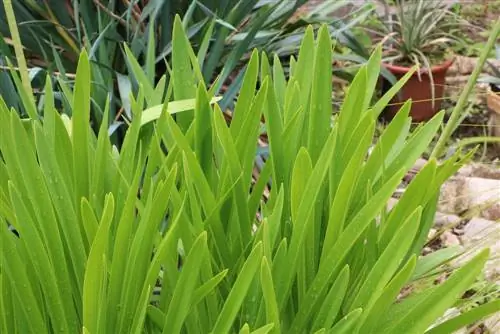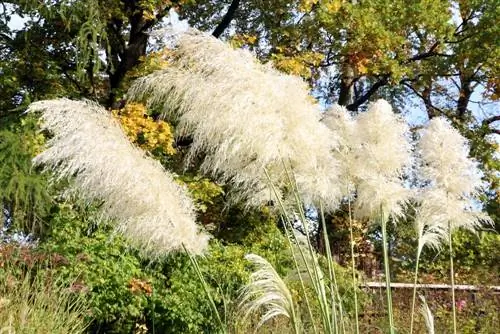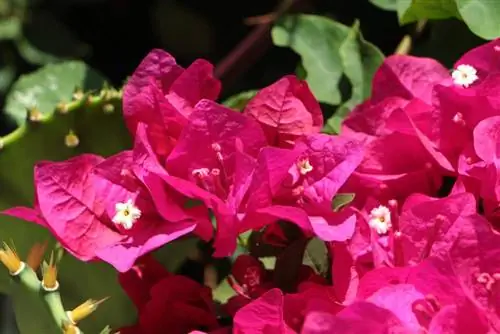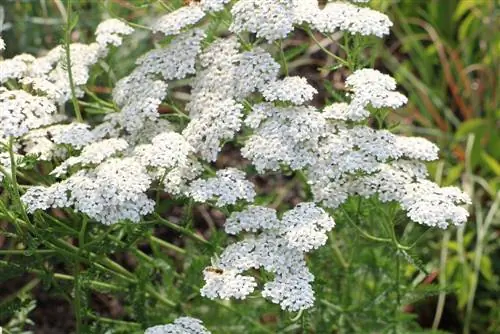- Author admin [email protected].
- Public 2023-12-17 03:39.
- Last modified 2025-01-24 12:45.
Agapanthus, a plant also known to us as the African lily, originally comes from Africa. This makes it clear that warmth is essential if this truly majestic plant is to thrive. Often, however, the Agapanthus simply doesn't want to bloom, which of course significantly affects its beauty. In addition to warm temperatures, a few other factors have to be right for the otherwise very robust plant.
Flowering time
Since the African lily is not hardy and would not survive a frosty night outdoors, it definitely needs to stay indoors during the winter months. Only from March, but even better from April, can you think about putting them on the terrace or balcony. Under normal circumstances it will then form buds very soon. This is usually the case from mid-April.
The buds then turn into a ball of buds within a relatively short period of time, which opens around May or June and reveals the typical, small blue heads that are characteristic of the Agapanthus. When these heads finally open, the plant blooms in all its glory. However, if this is not the case or the African lily has not formed any buds at all, then something went terribly wrong in advance.
Causes
Plant lovers often experience that the African lily does not bloom. The reasons for this have to do with either incorrect overwintering or insufficient nutrient supply. It's less common because of the location, as word has gotten around that the agapanthus likes it warm and sunny. The most common reasons why it doesn't want to bloom are:
- poor or incorrect care in autumn
- overwintering in a room that is far too dark
- too big a planter
- fundamentally incorrect care

The African lily is a very undemanding plant. However, she also wants to be looked after in autumn. This means that the soil must be kept moist at this time of year and fertilizer must be given at least once more. During the winter months, temperatures between five and ten degrees Celsius are ideal for the plant. It is important to have a sufficient supply of light, otherwise the Agapanthus may stop photosynthesis. The brightness should be in the range of 1,500 to 2,000 lux. Basically, the warmer it is during wintering, the higher the light value must be.
Under no circumstances should wintering take place in complete darkness. Finally, it is also important to note that the Agapanthus likes it to be cramped. It should therefore be kept very tightly in its planter and not repotted too early. If the planter is too large, the African lily will spend longer rooting and will stop blooming. In general, it can be said that there should be a maximum distance of two centimeters between the plant ball and the edge of the pot.
Tip:
It is always better to repot the African lily a little too late rather than too early - even if it may be difficult.
Measures
If the African lily doesn't bloom, every plant owner will of course do just about anything to get it to bloom. Unfortunately, it's not that easy with Agapanthus. Above all, you should be aware that even if you take immediate measures, it will most likely not bloom again until next season. Since the causes of the failure to bloom in the vast majority of cases occurred in autumn and winter, they can usually only be remedied at these times. However, that doesn't mean that you should do nothing and just wait for fall. Immediate measures include:
- carefully increase fertilization without doubling it
- choose a location that receives direct sunlight for a very long time
- If the planter is too large, immediately repot it into a smaller one
With these measures you will hardly get the agapanthus to bloom, but you will create ideal conditions so that the plant feels comfortable and is well prepared for the autumn and winter months.
Care tips
If you have done everything right during the winter months, the African lily will sprout buds again the following April and then bloom. The splendor of the flowers and, last but not least, the frequency of flowers can be supported or increased with a few targeted care measures. Casting is particularly important. The agapanthus likes it moist, but doesn't want to swim in water.
Tip:
It is best to water the African lily over the base in the morning and make sure that the water is gone in the evening.
Of course, a regular supply of nutrients is also very helpful. A fertilizer with the widest possible range of trace elements should definitely be used. Fertilization is best done via irrigation water. Fertilization needs to be carried out from the beginning of May to around the end of August. It is also important that fertilization is not forgotten in autumn. In any case, fertilization should definitely be carried out in September and October. Otherwise, the plant needs almost no attention.
No cut

The Agapanthus does not have to and should not be cut. If you are looking for plants that can be shaped into a desired shape, you should choose another alternative and not resort to the African lily. However, if yellow leaves form, they can of course be removed without any concerns. Either they are cut cleanly with plant scissors or carefully loosened by hand.






